
Researchers say they have uncovered the mechanism in which gold deposits are brought to the Earth's surface, according to a report.
The team of scientists discovered that a gold-sulfur complex coaxes the precious metal from deep underground to volcanic and magma rocks -- a process long debated, Forbes reported.
The researchers used "numeric modeling" to reveal the conditions that lead to the enrichment of gold in magmas that rise to the Earth's surface.
A certain type of sulfur under extreme pressure and temperatures 30 to 50 miles beneath active volcanoes "causes gold to be transferred from the mantle into magmas" that eventually migrate to the Earth's surface, the University of Michigan said in a release.
The researchers created a thermodynamic model based on lab experiments in which they controlled pressure and temperature to create artificial magma. The model can then be applied to real-world conditions.
"This thermodynamic model that we've now published is the first to reveal the presence of the gold-trisulfur complex that we previously did not know existed at these conditions," said Adam Simon, a University of Michigan professor and co-author of the study.
"This offers the most plausible explanation for the very high concentrations of gold in some mineral systems in subduction zone environments," he added.
The study, published in the Proceedings of the National Academy of Sciences, said the gold deposits associated with volcanoes form in so-called subduction zones, regions in which a continental plate is driving another plate. In the seams where they connect, magma from the Earth's mantle has the chance to rise to the surface.
"On all of the continents around the Pacific Ocean, from New Zealand to Indonesia, the Philippines, Japan, Russia, Alaska, the western United States and Canada, all the way down to Chile, we have lots of active volcanoes," Simon said. "All of those active volcanoes form over or in a subduction zone environment. The same types of processes that result in volcanic eruptions are processes that form gold deposits."







